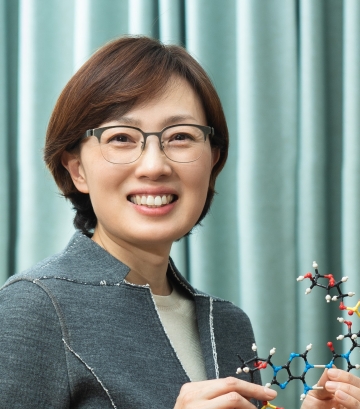Professor
Kim, V. Narry
Research
Biochemistry
Cell Biology
Genetics
Genomics
Molecular Biology
Virology
RNAs stand at the core of gene regulation. To understand their functions and mechanisms, we have been studying regulatory RNAs and RNA-binding proteins in stem cells, embryos, cancer, neuronal systems, and viruses, with the following specific topics.
microRNA: Tiny regulators with big roles
microRNAs are small noncoding RNAs involved in virtually all aspects of animal development and diseases including cell differentiation, cell proliferation, cell death, energy metabolism, and antiviral defense. Tight control of microRNAs is critical for normal functioning of cells, and the dysregulation of microRNAs is often responsible for human diseases. Our lab has made contributions to the current understanding of how microRNAs are generated and controlled, by elucidating the mechanism of microRNA biogenesis and identifying several key factors in the pathway, including DROSHA, DGCR8, LIN28, and TUTases. We have also been investigating the function and regulation of microRNAs in cancer and stem cells in hopes that our studies will provide new opportunities for cancer treatment and stem cell engineering.
RNA modifications: The tail wagging the dog
RNA modifications often determine the function and fate of the RNA. Detecting and analyzing such modifications is thus crucial in our understanding of RNA-mediated gene regulation. We discovered that microRNAs are uridylated or adenylated at the 3’ end and that these 3’ tails regulate the biogenesis and stability of microRNAs. More recently, we developed a technique called TAIL-seq that allows the genomic scale investigation of mRNA tails. Using this new tool, we discovered novel types of mRNA tails and we are currently investigating their functions in the context of development and diseases.
RNA binding proteins: The essential partners
RNAs never stay alone but instead partner with RNA-binding proteins that dictate the activity, stability, and localization of the RNAs. We are developing new tools to investigate the RNA-protein network, with mass spectrometry and sequencing techniques. Untangling this complex network will advance our understanding of the functions and mechanisms of RNAs in post-transcriptional gene regulation.
Viruses and vaccines: RNAs as invaders and defenders
For viruses to replicate their genome and evade their host’s defense system, it is crucial to manipulate the RNA pathways. We are working on viruses that cause major global health issues. In particular, we are currently focusing on coronaviruses to understand their RNA replication and gene expression, to help the ongoing global efforts to combat SARS-CoV-2. In addition, we are investigating mRNA stability control, which can provide the basis for the improvement of mRNA vaccines and therapeutics.
microRNA: Tiny regulators with big roles
microRNAs are small noncoding RNAs involved in virtually all aspects of animal development and diseases including cell differentiation, cell proliferation, cell death, energy metabolism, and antiviral defense. Tight control of microRNAs is critical for normal functioning of cells, and the dysregulation of microRNAs is often responsible for human diseases. Our lab has made contributions to the current understanding of how microRNAs are generated and controlled, by elucidating the mechanism of microRNA biogenesis and identifying several key factors in the pathway, including DROSHA, DGCR8, LIN28, and TUTases. We have also been investigating the function and regulation of microRNAs in cancer and stem cells in hopes that our studies will provide new opportunities for cancer treatment and stem cell engineering.
RNA modifications: The tail wagging the dog
RNA modifications often determine the function and fate of the RNA. Detecting and analyzing such modifications is thus crucial in our understanding of RNA-mediated gene regulation. We discovered that microRNAs are uridylated or adenylated at the 3’ end and that these 3’ tails regulate the biogenesis and stability of microRNAs. More recently, we developed a technique called TAIL-seq that allows the genomic scale investigation of mRNA tails. Using this new tool, we discovered novel types of mRNA tails and we are currently investigating their functions in the context of development and diseases.
RNA binding proteins: The essential partners
RNAs never stay alone but instead partner with RNA-binding proteins that dictate the activity, stability, and localization of the RNAs. We are developing new tools to investigate the RNA-protein network, with mass spectrometry and sequencing techniques. Untangling this complex network will advance our understanding of the functions and mechanisms of RNAs in post-transcriptional gene regulation.
Viruses and vaccines: RNAs as invaders and defenders
For viruses to replicate their genome and evade their host’s defense system, it is crucial to manipulate the RNA pathways. We are working on viruses that cause major global health issues. In particular, we are currently focusing on coronaviruses to understand their RNA replication and gene expression, to help the ongoing global efforts to combat SARS-CoV-2. In addition, we are investigating mRNA stability control, which can provide the basis for the improvement of mRNA vaccines and therapeutics.
Education/Career
Education
- - 1994 - 1998 Ph. D., Biochemistry, Oxford University
- - 1992 - 1994 M. S., Microbiology, Seoul National University
- - 1988 - 1992 B. A., Microbiology, Seoul National University
Career
- - 2017 - present SNU Distinguished Professor, Seoul National University
- - 2013 - present Professor, Seoul National University
- - 2012 - present Director, Center for RNA Research, Institute for Basic Science
- - 2010 - present SNU Distinguished Fellow, Seoul National University
- - 2008 - 2010 Associate Professor, Seoul National University
- - 2004 - 2008 Assistant Professor, Seoul National University
- - 2001 - 2004 Research Assistant Professor, Seoul National University
- - 1999 - 2001 Postdoctoral fellow, Howard Hughes Medical Institute, University of Pennsylvaniaof Pennsylvania
Publications
- J. J. Seo1, S.-J. Jung1, J. Yang, D.-E. Choi, V. N. Kim* (2023) “Functional viromic screens uncover regulatory RNA elements” Cell, 186:3291-3306.
- Y. Lee1, H. Kim1, V. N. Kim* (2023) “Sequence determinant of small RNA production by DICER” Nature, 615:323–330.
- Y. Lee1, H. Lee1, H. Kim1, V. N. Kim*, S. H. Roh* (2023) “Structure of the human DICER–pre-miRNA complex in a dicing state” Nature, 615:331-338.
- D. Kim1, J.-Y. Lee, J.-S. Yang, J. W. Kim, V. N. Kim*, and H. Chang* (2020) “The architecture of SARS-CoV-2 transcriptome” Cell, 181(4):914-921.e10.
- J. Lim1, D. Kim1, Y. Lee1, M. Ha, M. Lee, J. Yeo, H. Chang, J. Song, K. Ahn, V. N. Kim (2018) “Mixed tailing by TENT4A and TENT4B shields mRNA from rapid deadenylation” Science, eaam5794.
- S. C. Kwon1, T. A. Nguyen1, Y.-G. Choi1, M. H. Jo, S. Hohng, V. N. Kim*, J.-S. Woo* (2016) “Structure of Human DROSHA” Cell, 164(1-2):81-90.
- J. Lim1, M. Ha1, H. Chang1, S. C. Kwon, D. K. Simanshu, D. J. Patel, and V. N. Kim (2014) “Uridylation by TUT4 and TUT7 marks mRNA for degradation” Cell, 159(6):1365-1376.
- Heo1, M. Ha1, J. Lim, M.-J. Yoon, J.-E. Park, S. C. Kwon, H. Chang and V. N. Kim (2012) “Mono-uridylation of pre-microRNA as a key step in the biogenesis of group II let-7 microRNAs” Cell, 151: 521-532.



